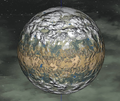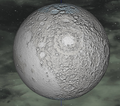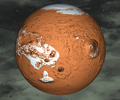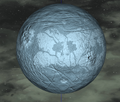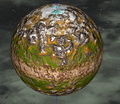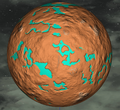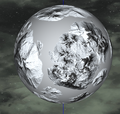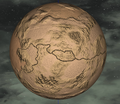Planets
There are eight planets and moons in the Space Engineers Star System.
You may be looking for Planetary Maps.
What are planets/moons?
In-game planets, moons, and asteroids are large, immobile, destructible voxel objects. Players can terraform voxels in Creative Mode using Voxel Hands. In Survival Mode, you can drill the voxel material.
Each planet has their own gravity field and ores. Some planets have an atmosphere, Weather, NPC bases, flora and fauna.
In contrast to real life, planets in game range in size from only 19km to 120km in diameter. They do not spin nor move along any orbits.
Planets and their Moons
| Planet: | EarthLike Planet | Mars | Alien planet | Triton | Pertam |
|---|---|---|---|---|---|
| Moon: | Moon | Europa | Titan | (no moon) | (no moon) |
Gallery
The following images are cloudless 3D renders created by Reddit user u/AhCrapItsYou (Source Reddit).
| Planet: | Earth-like globe | Mars globe | Alien Planet globe | Triton globe | Pertam globe |
|---|---|---|---|---|---|
| Moon: | Moon globe | Europa globe | Titan globe |
Ore Generation
| Celestial Body | Ice | Platinum Ore | Uranium Ore | Cobalt Ore | Gold Ore | Silver Ore | Magnesium Ore | Nickel Ore | Silicon Ore | Iron Ore | Stone |
|---|---|---|---|---|---|---|---|---|---|---|---|
| Planets | Yes | No | No | Yes | Yes | Yes | Yes | Yes | Yes | Yes | Yes |
| Asteroids | Yes | Yes | Yes | Yes | Yes | Yes | Yes | Yes | Yes | Yes | Yes |
| Moons | Yes | Yes | No | Yes | Yes | Yes | Yes | Yes | Yes | Yes | Yes |
Measurements
This table lists the standard planets, their distance from the center (?), their diameter in kilometres, and their GPS coordinates. The values are obtained through SEToolbox.
| Name | Distance | Diameter | GPS |
|---|---|---|---|
| EarthLike | 227.02 | 120.00 | GPS:EarthLike:0.50:0.50:0.50: |
| Moon | 176.92 | 19.00 | GPS:Moon:16384.50:136384.50:-113615.50: |
| Mars | 1749.29 | 120.00 | GPS:Mars:1031072.50:131072.50:1631072.50: |
| Europa | 1835.76 | 19.00 | GPS:Europa:916384.50:16384.50:1616384.50: |
| Triton | 2542.14 | 80.25 | GPS:Triton:-284463.50:-2434463.50:365536.50: |
| Pertam | 4079.73 | 60.00 | GPS:Pertam:-3967231.50:-32231.50:-767231.50: |
| Alien | 5600.00 | 120.00 | GPS:Alien:131072.50:131072.50:5731072.50: |
| Titan | 5783.85 | 19.00 | GPS:Titan:36384.50:226384.50:5796384.50: |
Tip: You can copy the entire table and use "New from clipboard" in the game's GPS window, then double-click each one to mark it non-temporary.
How to customise your star system
Planets’ Game Mechanics
In real life, a planet is a round celestial body that orbits a star on a cleared path. A moon is a natural satellite, a celestial body that orbits a larger body, possibly together with other moons or rings. Asteroids are irregularly shaped small objects that orbit a star, typically in clusters.
In game, asteroids, moons, and planets are technically exactly the same objects: Voxels arranged in different size and shape.
- Planets, moons, and asteroids are completely immobile and never actually move along any orbits, no matter how much force or gravity is applied.
- Planets, moons, and asteroids have in common that they are fully destructible voxels with Ore deposits on them.
- Planets are 60 to 120 km in diameter.
- Moons are simply smaller planets, only 19km in diameter, and possess only weak gravitational fields of 0.25 g.
- Asteroids in game are again much smaller than moons and planets. Asteroids have no perceivable gravity.
Planetary Surface Generation
While their surfaces appear randomly generated, they're in fact pre-loaded voxel models. When you start a Sandbox Game, there is no procedural generation for Planets or Moons, they are always the same. That means you can copy and paste valid GPS locations across (unmodded) games.
Each planet type will spawn the appropriate environment models and surface textures associated with its template. The same properties are applied even when a planet is spawned in manually by the player using the Spawn Menu (SHIFT key+F10 key) in Creative Mode.
When a player in creative mode increases the size of a manually spawned Planet, the game simply stretches the planetary models to accommodate for the new size. The textures and vegetation distribution adjust to the new size to look natural, only the surface model is stretched.
Ores on planets and moons are easier to find, because there are more deposits and several are always clustered together within 150m below the surface. Asteroids, in contrast, contain larger deposits, but they are further apart and spread out over a larger 3D volume of space and many asteroid contain only stone.
Related Mods
- Add more planets from the Steam Workshop
- Add more planets from Mod.io
- For Modders the spawn menu contains a SystemTestMap.


